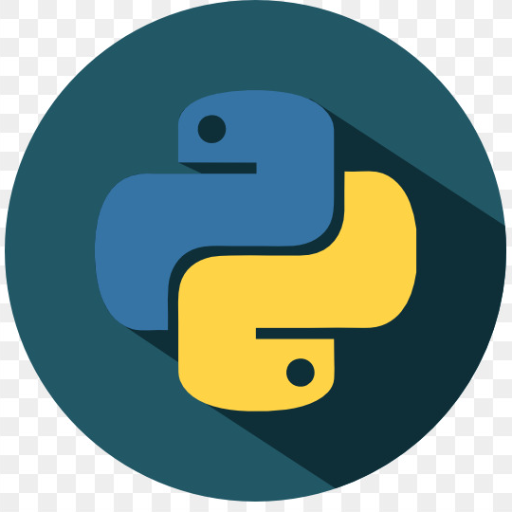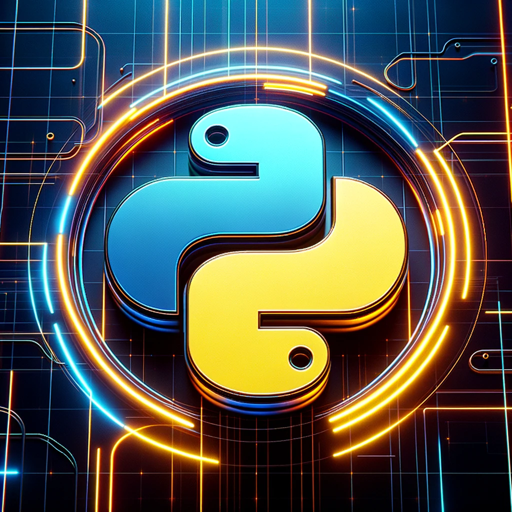Python-Python programming for everyone
AI-powered Python development tool
🐍 Generate a full snake game with instructions
📝 Create a script to analyze this file
🪲 Find any bug or improvement in my code
💡 Teach me a useful skill or trick in Python
Related Tools
Load More
Learn: Python
First steps of learning Python

Python Code Expert
Develop Python applications that are efficient, maintainable, testable, performant, and robust. Excels at OOP design, error handling, documentation, logging, and much more. Includes unit tests written in pytest for all code snippets.
Python Coding Companion
Assists in creating and understanding python applications and scripts.

Python hacker
Autonomous Python hacker expert, handling coding tasks without user input.

Python Tutor
Concise, example-focused Python programming tutor for beginners to intermediates.

Python Expert
Practical Python tutor with a focus on real-world applications and hands-on learning with projects.
20.0 / 5 (200 votes)
Introduction to Python
Python is a high-level, interpreted programming language known for its simplicity and readability. It was created by Guido van Rossum and first released in 1991. Python's design philosophy emphasizes code readability and simplicity, making it an excellent choice for both beginners and experienced programmers. Its syntax allows developers to express concepts in fewer lines of code compared to other languages like Java or C++. Python is dynamically typed and garbage-collected, supporting multiple programming paradigms, including procedural, object-oriented, and functional programming.

Main Functions and Use Cases of Python
Web Development
Example
Using frameworks like Django and Flask
Scenario
Developers can quickly build robust web applications using Django, a high-level framework that encourages rapid development and clean, pragmatic design. Flask, a micro-framework, allows for greater flexibility and control, making it ideal for smaller projects or APIs.
Data Analysis and Visualization
Example
Utilizing libraries such as pandas, NumPy, and Matplotlib
Scenario
Data scientists and analysts use pandas for data manipulation and analysis, NumPy for numerical computations, and Matplotlib for creating static, animated, and interactive visualizations. These tools are essential for tasks such as data cleaning, statistical analysis, and plotting data trends.
Machine Learning and AI
Example
Leveraging frameworks like TensorFlow, Keras, and scikit-learn
Scenario
Python's machine learning libraries make it the go-to language for AI development. TensorFlow and Keras are used for building and training deep learning models, while scikit-learn is ideal for implementing basic machine learning algorithms. These tools enable the creation of predictive models, natural language processing applications, and more.
Ideal Users of Python
Beginners and Educators
Python's straightforward syntax and readability make it an excellent first language for beginners. Educators prefer Python for teaching programming concepts because students can focus on learning the principles without getting bogged down by complex syntax. Python's extensive community and resources also provide ample support for new learners.
Data Scientists and Analysts
Data professionals benefit from Python's powerful libraries for data manipulation, analysis, and visualization. Its ease of integration with other languages and tools, such as R and SQL, along with its ability to handle large datasets efficiently, make Python indispensable in data science.

Detailed Guidelines for Using Python
Step 1
Visit aichatonline.org for a free trial without login, also no need for ChatGPT Plus.
Step 2
Install Python from the official Python website (python.org) ensuring you download the version suitable for your operating system. Follow the installation instructions provided.
Step 3
Set up an Integrated Development Environment (IDE) such as PyCharm, VSCode, or even Jupyter Notebook for an optimal coding experience. These tools provide a user-friendly interface and useful features for writing and debugging Python code.
Step 4
Familiarize yourself with Python’s syntax and core libraries by going through the official Python documentation and tutorials. You can start with simple scripts and gradually move to more complex projects.
Step 5
Join Python communities and forums like Stack Overflow, Reddit’s r/learnpython, or Python Discord groups to seek help, share knowledge, and stay updated with the latest Python trends and libraries.
Try other advanced and practical GPTs
Python
AI-powered Tool for Python Mastery

画像アイデアを考える君
AI-powered image idea generator.

无限星球模拟器
Explore planets with AI-powered simulations

足球赛事分析师
AI-Powered Football Betting Insights.

Flash Card Creator
AI-powered Flash Cards for Smarter Learning

議事録作成AI by EEC
AI-Powered Meeting Minutes Creation

Python
Your AI partner for Python programming

Python
AI-powered tool for Python coding

Jail Breakinator 2.0
AI-Powered Creativity Unleashed

Jailbreak Me
Unlock the AI, Defy the Code!
Persona Creator
AI-powered buyer persona creation.

Legal Case Brief Assistant
AI-powered tool for effortless case briefing

- Data Analysis
- Automation
- Web Development
- Game Development
- Machine Learning
Comprehensive Python Q&A
What is Python used for?
Python is a versatile programming language used for web development, data analysis, artificial intelligence, scientific computing, automation, and more. Its simple syntax and extensive libraries make it suitable for both beginners and experienced developers.
How do I install Python on my computer?
You can install Python by visiting the official Python website (python.org), downloading the installer for your operating system, and following the installation instructions. Make sure to add Python to your system's PATH during the installation process.
What are some popular Python libraries?
Popular Python libraries include NumPy and pandas for data analysis, Matplotlib and Seaborn for data visualization, TensorFlow and PyTorch for machine learning, Flask and Django for web development, and requests for handling HTTP requests.
How can I learn Python effectively?
To learn Python effectively, start with online tutorials and courses, practice coding regularly, build small projects to apply your knowledge, and participate in coding challenges. Reading Python documentation and joining Python communities can also be very helpful.
What is an Integrated Development Environment (IDE) and why should I use one?
An Integrated Development Environment (IDE) is a software application that provides comprehensive facilities to programmers for software development. It typically includes a code editor, debugger, and build tools. Using an IDE like PyCharm or VSCode can enhance your productivity by providing code completion, syntax highlighting, and debugging tools.